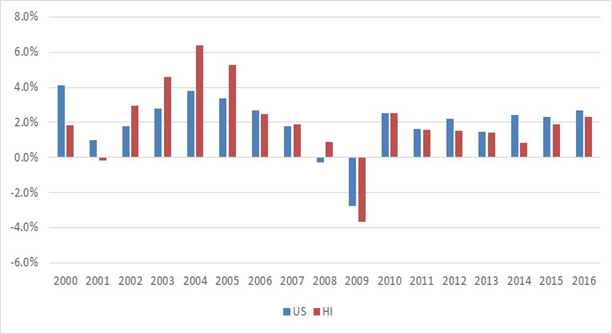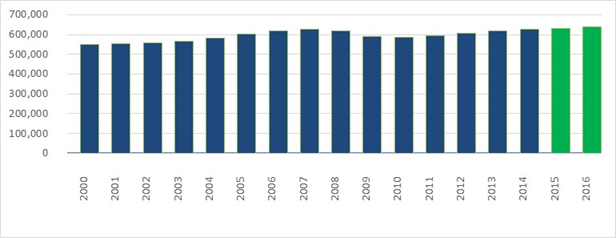HAWAII ECONOMY CONTINUES HEALTHY GROWTH
DBEDT News Release 15-07, August 20, 2015
HONOLULU—In its third quarter 2015 Statistical and Economic Report, the Department of Business, Economic Development & Tourism (DBEDT) projects that Hawaii’s economy will accelerate growth rates in 2015 and 2016.
In its most recent data release in June 2015, the U.S. Bureau of Economic Analysis (BEA) revised data on gross domestic product for all the states. According to the new estimates, Hawaii’s economic growth (the growth of real gross domestic product) has been below that of the U.S. in the past three years. In 2014, the BEA’s estimate of Hawaii’s economic growth rate was only 0.8 percent, the lowest since the most recent recession in 2009.
Figure 1. Economic Growth Rate for the United States and Hawaii: Actual 2000-2014, Projections 2015 and 2016

Based on the revised data by BEA, DBEDT projects that Hawaii economic growth rate for 2015 is 1.9 percent and 2.3 percent for 2016. These projected growth rates are much higher than the average growth rate of 1.3 percent experienced during the last four years.
“Although we haven’t seen the 5.0 to 6.0 percent economic growth rates experienced during the previous business cycle, our economy has recovered since 2011, Hawaii has been on the expansion path,” said DBEDT Director Luis P. Salaveria. “Our employment and payroll job count both were fully recovered by last year and during the first half of 2015, both reached the historic high levels. Our unemployment rate during the first half of 2015 was the 7th lowest in the nation.”
For the current economic projection, DBEDT projects that the non-agriculture payroll jobs will increase by 1.1 percent in 2015 and 1.2 percent in 2016, the same as the projection made last quarter. During the first half of 2015, the non-agriculture payroll job count increased 1.1 percent.
Figure 2. Non- Agriculture Wage and Salary Jobs: Actual 2000-2014, Projections 2015 and 2016

DBEDT expects the unemployment rate will drop to 3.9 percent by the end of this year, resulting in an average unemployment rate of 4.0 percent (not seasonally adjusted) in 2015 and will further decrease to 3.7 percent in 2016.
The initial unemployment claims, another indicator for the labor market condition, declined 17.4 percent as of August 5, 2015, from the same period last year. In a typical week during the first seven months of 2014, 1,700 people filed applications for unemployment benefits, and that number dropped to 1,400 during the first seven months of 2015.
Nominal (no inflation adjustment) personal income growth is projected to grow at 4.3 percent in 2015 and 4.6 percent in 2016, the same as projected in the previous quarter. However, with a lower inflation rate caused by the lower oil price, Hawaii consumers benefited from a stronger purchasing power from income. DBEDT estimated that real personal income increased 2.8 percent in 2014, and will increase by 3.5 percent in 2015 and 2.9 percent in 2016. These real personal income growth rates are higher than those projected in the previous quarter.
The consumer inflation rate, as measured by the Honolulu Consumer Price Index for Urban Consumers (CPI-U) increased only 0.7 percent during the first half of 2015, mainly caused by the sharp decline in the price of oil. DBEDT expects that the consumer inflation rate will increase slightly during the second half of 2015, averaging for the year at 1.0 percent inflation rate. According to the Blue Chip Economic Indicators, the U.S. consumer inflation will increase only 0.3 percent in 2015. Hawaii’s inflation is higher than the U.S. due to the heavier dependence on oil in Hawaii.
Figure 3. Growth of Nominal Personal Income: Actual 2000 – 2014, Projections 2015 and 2016

The construction industry continues to boom. The value of private building permits issued during the first half of 2015 increased by 36.6 percent as compared with the same period a year ago. Leading the increase was the value of commercial and industrial construction permits with a 183.4 percent increase, followed by residential permits with a 96.2 percent increase. The value of permits for additions and alterations declined by 20.1 percent during the first half of 2015. Value of government contracts awarded also increased by 102.6 percent during the first half of 2015. Construction jobs increased 3.1 percent during the first half of 2015, the second highest growth among all the industries (the highest payroll job growth was in arts, entertainment, and recreation with 3.3 percent growth).
Visitor arrivals, including those coming by air and by cruise ships, increased 4.0 percent and visitor expenditures expanded 3.5 percent during the first half of 2015. DBEDT expects that visitor arrivals will reach 8.7 million in 2015, a growth of 4.3 percent from last year. This growth rate is higher than the 2.5 percent projected in May of this year. Visitor spending is expected to increase 3.8 percent in 2015, also higher than the 2.0 percent projected last quarter. The main reason for raising the visitor growth rate is the continued growth in scheduled air seats which will increase by 4.7 percent during the second half of 2015.
DBEDT expects healthy economic growth to continue into the future, as seen by real GDP growth projected to be 2.4 percent in 2017 and 2018. Though lower than previously expected, economic growth is well above the average growth rate experienced during the last 20 years. The current economic expansion is expected to continue for a few years.
The DBEDT Quarterly Statistical and Economic Report contains more than 100 tables of the most recent quarterly data on Hawaii’s economy as well as narrative explanations of the trends in these data. View the full report.
---30---
DLIR: HAWAII’S UNEMPLOYMENT RATE DROPS TO 3.7 PERCENT IN JULY